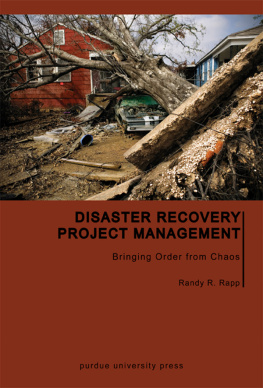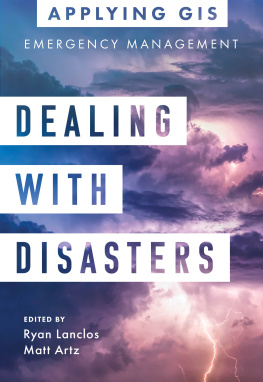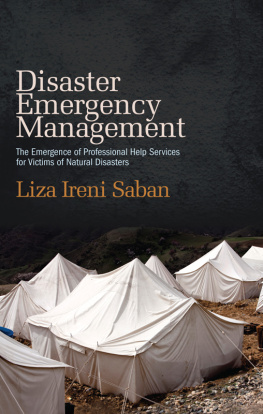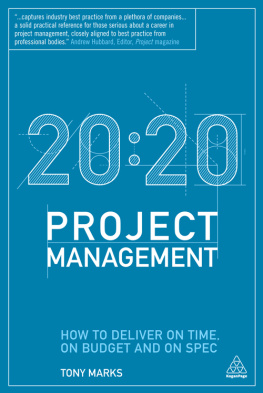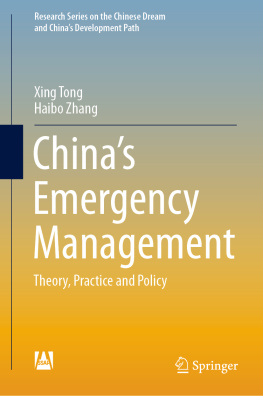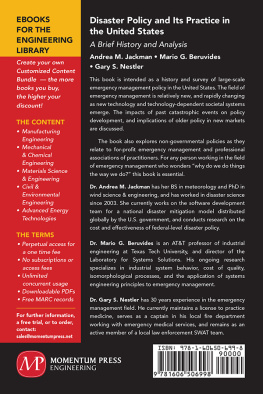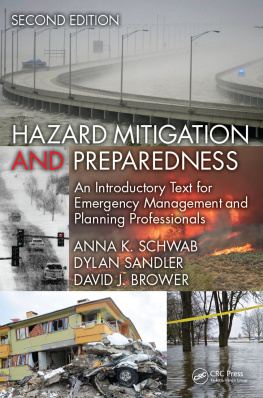DISASTER RECOVERY PROJECT MANAGEMENT
DISASTER RECOVERY PROJECT MANAGEMENT: BRINGING ORDER FROM CHAOS
by
Randy R. Rapp
Purdue University Press
West Lafayette, Indiana
Copyright 2011 by Randy R. Rapp. All rights reserved.
Printed in the United States of America.
Library of Congress Cataloging-in-Publication Data
Rapp, Randy R.
Disaster recovery project management : bringing order from chaos / by Randy R. Rapp.
p. cm.
Includes bibliographical references and index.
ISBN 978-1-55753-588-7 (cloth) -- ISBN 978-1-61249-166-0 (epdf) -- ISBN 978-1-61249-167-7 (epub) 1. Building--Superintendence. 2. Emergency management. I. Title.
TH438.R34 2011
363.34068--dc23
2011018725
Some of the book has been copied in whole or in part from the authors work published over the years in the Cost Engineering journal of AACE International. They are separately cited and reprinted with the permission of AACE International, 209 Prairie Ave., Suite 100, Morgantown, WV 25601 USA. Phone: 800-858-COST/304-296-8444; Fax: 304-291-5728; Web site: . Copyright 2002-2010 by AACE International; all rights reserved.
Unless otherwise credited, the author created or photographed the figures.
TABLE OF CONTENTS
PREFACE
The catastrophes imposed on humankinds constructed infrastructure seem to more frequently crowd the news media now than decades ago. The heartbreaking mayhem from the earthquakes in Chile, New Zealand, and Japan; the environmental havoc from the oil leak into the Gulf of Mexico; riverine flooding in Australia and the Midwest United States; and volcanic ash spewing from Iceland are some of the more recent disasters the world has seen. Most observers probably soberly reflect that devastating calamities might also befall them. Mankinds efforts to control nature can seem futile. Yet the need to rebuild remains. People are resilient, and inspired leadership can work wonders, but resources are almost always limited. No one disputes that those charged to recover the built environment after disasters must be skilled at their tasks.
This book is written to improve post-emergency management of built infrastructure recovery projects. It informs practitioners who have minimal firsthand experience with such work about its special challenges. Readers who are new to those operations or transitioning from other kinds of work should be able to adapt quicker to recovery than someone who has not read this book.
Some characteristics of facility restoration and reconstruction projects are different from conventional construction. The technical and managerial dimensions of recovery work require an array of knowledge, skills, and traits that even seasoned conventional constructors may not fully realize. The book should help develop recovery managers who are at least a little savvier, a little quicker to act appropriately than if they have minimal prior firsthand experience with restoration and reconstruction. Of course, the operative word is manager. The primary duty of a manager is to make good decisions. Good decisions come from capacity to deal with broad arrays of facts and figures that impact the appropriateness of the decisions. Nuances can make the difference between good decisions and choices that are mediocre or poor.
The need for a book on this subject seemed obvious as the author developed the curriculum for the concentration in Disaster Restoration and Reconstruction Management for the Building Construction Management Department at Purdue University. There was no single publication that was generally appropriate as a text for a formal collegiate disaster restoration and reconstruction project management course. None distinctly informed and guided contractors who restore and reconstruct the built environment after emergency conditions stabilize.
Books about disaster mitigation, relief planning, or emergency operations management are not uncommon, but they are not really within the purview of restoration and reconstruction contractors. The number of construction project management books grows almost every year. However, conventional construction project management books stop short of what a recovery construction manager might find most informative. Additional research for a number of journal and conference papers about disaster recovery, plus collaboration with Ted Douglas for a well-received disaster recovery panel discussion at the 2010 AACE International meeting, only confirmed the likely usefulness of a book such as this.
The author personally experienced and observed in others that they who have managed other construction work and find themselves immersed for the first time in projects organized to restore and reconstruct facilities have at least a small experience curve to descend, especially in the technical realm. This is more so, if the work is their first for a government owner.
No book of reasonable size can adequately address all significant details of any kind of disaster that might erupt. New requirements evolve all the time. The scope of disasters can range from a kitchen grease fire that inconveniences one household to a hurricane or volcanic eruption that devastates a geographic region. The book offers enough breadth and depth that professionals should be able to adapt its content to their unique circumstances, so that they manage disaster recovery projects better than they otherwise would.
The text is divided into three sections:
1. The first explains the nature of disasters and the special requirements placed upon disaster recovery contractors. They are tied to the competitive nature of the project environment and concepts that enable project manager success.
2. The second section relates project management practices and principles commonly necessary for disaster recovery. Presuming some prior reader experience or education in conventional construction project management, the chapters address the demands of larger disaster recovery projects. Author experience recovering housing and facilities after Hurricanes Katrina and Wilma and serving with the Restore Iraqi Oil program provides the empirical basis for much of this section.
3. The last section is technically focused on equipment and procedures applied by contractors to restore or remediate water, fire, and smoke damage, and mold losses. Seasoned constructors with little or no prior exposure to the techniques of restoration operations will likely find this section most informative. The people and technical courses and references of the Restoration Industry Association (RIA), the Institute for Inspection, Cleaning, and Restoration Certification (IICRC), and the Federal Emergency Management Agency (FEMA) underlie these chapters.
Besides the contractors, professionals who plan the work and administer public and private built infrastructure recovery programs should find the contents relevant to understand what they should expect of contractors whom they hire.
Thanks go to Mr. Daniel Bernazzani of DryAdvise by Liberty Consulting and Mr. Peter Consigli of the RIA for their keen critiques of the book. Dr. David McEntire, Ph.D., of the University of North Texas offered very useful perspectives about disasters. Mr. Edward E. (Ted) Douglas carefully reviewed . Many of their suggestions were included to make the book better than it otherwise would be. Any inaccuracies or other deficiencies in the manuscript remain entirely mine.
I dedicate this book to the memories of Edward Fisk, Dr. Frank Gerig, Ph.D., and Dr. Norbert Schmidt, Ph.D. Their excellence as caring educators and practitioners inspired me professionally.
Randy R. Rapp
Lafayette, Indiana
April 2011
SECTION I
INTRODUCTION TO DISASTER RECOVERY

